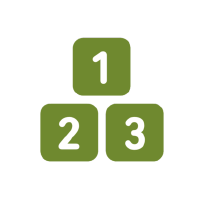
Count, Group and Compare
WHY?
Becoming good at math begins long before a child enters school. Even infants are wired to learn simple math ideas, including small numbers, patterns and making comparisons. You don’t need to be a math teacher to start preparing your child to be a problem solver. There are fun and simple activities that you can do now to build math and thinking skills.
Play Music We all have a natural love of music. Share this love with your child. Play gentle music or sing when you are together. This is a fun and easy way to expose your child to rhythm and patterns. Lots of nursery rhymes and children’s songs involve counting.
Move in Rhythm Clap, tap, rock or kiss your baby in a steady rhythm. Count while you do it. For example, while dressing your infant, tap their tummy three times. Repeat this. Have fun and make silly faces. This is a good way to teach your infant about counting.
Count Objects Count groups of things, starting with small numbers. For example, count your child’s toes or pieces of fruit. Infants learn through all of their senses, so hold objects up for your child to see and touch. “Look, there’s one…two bananas. Two bananas.”
Compare Provide opportunities for your child to touch and explore things that are the same and different. For example, let your baby shake things that make different sounds, or touch fabrics with different textures. Talk about how they are similar or different.
Use Math Words When you talk to your infant, use words related to math ideas like quantities and comparisons. For example, words like “more, less, big, small, tall, short, round, square.” You don’t need to set aside special time to do this. You can use math words whenever you are with your child.
Compare Sizes Talk to your baby about things that are different sizes. For example, put their hat next to yours and say “Who wears the little hat? Aaron! Who wears the big hat? Mommy!”
Less and More As you go about your regular routine, find opportunities to compare amounts using “less” and “more.” For example, “Do you want more bananas? Now they are all gone!”
What’s Inside? Wrap an object in a piece of paper. See if your baby can remove the paper to find what’s inside. Talk about what they found and the crinkle sound the paper made.
Stack Towers Help your baby stack blocks or other objects like plastic cups. Describe what they are doing using size and position words. They will love knocking the tower over!
Fill Up and Dump Out Give your baby a container to scoop and dump water in the bathtub. Use words like “in” and “out,” “full” and “empty.”
Count Count with your toddler. Move to bigger numbers as they get the hang of it. Young children learn through all of their senses, so have them point to and touch the objects you count.
Add and Subtract Explore what happens when you add or take away items from a group. “You have three crackers. How many will you have if you eat one?”
Name Shapes Look for shapes around you. “The clock is a circle. Do you see any other circles?” This could be a fun game when you are out doing errands.
Match and Sort Make a game of matching and sorting objects into groups. Your child can match and sort items by their shape, color, size or other features.
Compare Sizes, Amounts and Weights For example, describe things as “large, small, light, heavy.” Ask your child which objects are larger or smaller.
Put Things in Order Practice putting things in order. For example, your child could arrange dolls from smallest to largest, youngest to oldest, or heaviest to lightest. See what other categories they come up with!
Make Math Part of Your Life Math plays a part in life even when we don’t realize it. For example, to prepare dinner, you measure ingredients, set the oven timer and count plates. Find ways to let your child help.
Use Music Clap and dance with your child. Your child will be learning about patterns while having fun.
A-B-A-B Have fun with patterns. With an older child, alternate grapes and strawberries. Ask “What comes next?” Can your child make a pattern?
Scoop Water Give your child some containers to scoop and dump water in the bathtub. They might enjoy pouring water back and forth between containers of different size.
Puzzle Time Expose your child to shape sorters or simple puzzles. Let them take the lead and problem solve. Provide help when needed, like labeling shapes or encouraging them to turn pieces when needed.
Find the Match In the kitchen, give your child a container and two lids. See if they can figure out which lid fits and then put it on. Use size and shape words like “longer” and “wider.” If they get the hang of it, try more containers and lids.
Helping Hand Ask your child to bring you a specific number of objects. “Can you bring me two books to read?” Increase the numbers as they learn.
Build Encourage your child to build with blocks or other objects like empty cereal boxes. Watch as they experiment with combining shapes and testing balance. Describe what they are doing using position words like “below” or “above.”
Measure While Cooking Find safe ways for your toddler to help while you are cooking in the kitchen, like counting and helping to measure ingredients.
Count Around Town Count and find numbers in your community! You can count the sidewalk squares or look for numbers on signs.
Add and Subtract Count with your child using your fingers. Fold down one finger and count how many are left. Hold up a few fingers on the other hand and count how many you have now.
Grocery Helper The next time you go to the store with your child, give them a job. Use “size words” when you ask them to help you. Say, “We need three large potatoes” or “Can you find two small red onions?”
Puzzle Play. Do a puzzle (you can make one by drawing a picture and cutting it into a few pieces). If your child needs help, give hints using position words like “below” or “above.”
Make Patterns Make a movement pattern game. Take a step, then a hop, then a step, then a hop. Let your child choose the next movement to add.
Match and Sort Match and sort objects by their features like color, shape, size, or what they do. For example, your child an help sort the silverware when you put it away.

